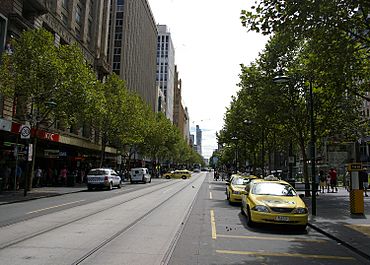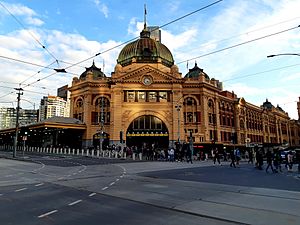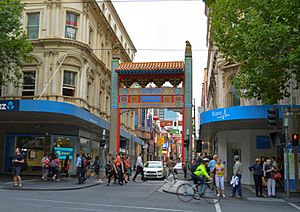Swanston Street facts for kids
Quick facts for kids Swanston StreetVictoria |
|
|---|---|
 |
|
| Swanston Street near City Square, March 2008 | |
| General information | |
| Type | Street |
| Length | 2.8 km (1.7 mi) |
| Opened | 1837 |
| Route number(s) | (through Parkville) |
| Former route number |
(through Melbourne) |
| Major junctions | |
| North end | Princes Hill, Melbourne |
|
|
| South end | Melbourne CBD |
| Location(s) | |
| LGA(s) | City of Melbourne |
| Suburb(s) | Princes Hill, Carlton, Melbourne CBD |
Swanston Street is a famous and important street in the heart of Melbourne, Victoria, Australia. It was created in 1837 when the city was first planned. The street cuts right through the middle of Melbourne's city center.
Today, Swanston Street is best known for being the world's busiest corridor for trams. It's also a popular shopping area with many historic buildings. The street was named after Charles Swanston, who was an important banker and politician.
Swanston Street runs north to south. At its southern end, it connects with St Kilda Road. At its northern end, it reaches the suburb of Carlton near the Melbourne Cemetery.
Contents
The History of Swanston Street
From Horses to Cars
When Swanston Street was first built in 1837, it was part of the original city plan called the Hoddle Grid. In the 1800s, people and horse-drawn carriages used the street, and it looked much like a grand European avenue. Soon, tram tracks were added, making it a major route for public transport.
When cars became popular in the early 20th century, Swanston Street turned into a very busy road. For many years, it was a main path for cars traveling through the city.
A Major Makeover
By the late 20th century, the street had problems with heavy traffic and pollution. It also had many discount stores and fast-food restaurants that made it feel run-down.
In 1992, the city decided to make a big change. A large section of the street, between Flinders Street and La Trobe Street, was closed to most cars during the day. This new pedestrian-friendly area was called the Swanston Street Walk. As part of the project, several public sculptures were added, including a famous little bronze dog named Larry La Trobe.
Becoming Car-Free
Even after the 1992 changes, there were still debates about cars on Swanston Street. In 2008, the new Lord Mayor of Melbourne, Robert Doyle, suggested letting cars back on the street. Many people and groups who supported public transport and cycling were against this idea.
In a surprising turnaround, by 2010, the Lord Mayor announced a new plan to make the entire street car-free. The project, which cost over $25 million, added city squares and large tram stops. The work began in 2011 and was finished in 2012. Now, only trams, emergency vehicles, and delivery trucks at certain times are allowed.
A Street for Celebrations and Protests
Because it is so central, Swanston Street is often used for big public events. This means the road is sometimes closed for parades, marches, and rallies.
Some of the exciting annual events held on the street include:
- The Moomba parade
- The AFL Grand Final parade
- The Melbourne Cup parade
The street is also the main route for the Anzac Day parade, which leads to the Shrine of Remembrance on St Kilda Road. It is also a common place for people to gather for protests to share their views on important issues.
Famous Buildings on Swanston Street


Many of Melbourne's most famous buildings and landmarks are located along Swanston Street. Some of them include:
- Flinders Street railway station
- Federation Square
- St Paul's Cathedral
- Melbourne Town Hall
- Capitol Theatre
- City Square
- Manchester Unity Building
- Chinatown Archway
- State Library of Victoria
- Melbourne Central Shopping Centre
- City Baths
Both RMIT University and the University of Melbourne also have large campuses with buildings facing the street.
Getting Around on Swanston Street
Swanston Street is a hub for public transport. Eight different tram routes run along the street, making it the busiest tram corridor in the world.
Two of Melbourne's busiest train stations are also on the street. Flinders Street station is at the southern end, and the underground Melbourne Central station is located further north. The Metro Tunnel, a new underground rail line, was built under Swanston Street and opened in 2025.
The street is also a key route for cyclists. Bike lanes connect it to the suburbs and the Capital City Trail along the Yarra River. In the past, safety for cyclists was a concern, especially around large buses. This led to changes to improve safety for everyone using the street.
Gallery
-
Swanston Street near RMIT University in August 2017.
-
Flinders Street station on the corner of Flinders and Swanston streets in August 2012.











